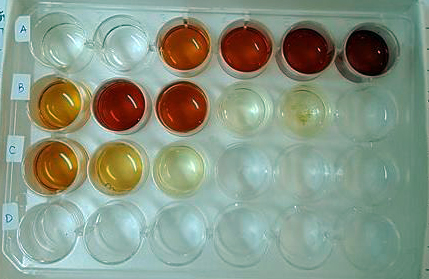ชุดการทดลองเคมีแบบย่อส่วนต้นทุนต่ำเพื่อสนับสนุนความเข้าใจมโนมติ เรื่อง สมดุลเคมี สำหรับนักเรียนระดับชั้นมัธยมศึกษาปีที่ 5
Main Article Content
Abstract
Suparb Tamuang, Karntarat Wuttisela and Saksri Supasorn
รับบทความ: 14 มิถุนายน 2560; ยอมรับตีพิมพ์: 8 ตุลาคม 2560
บทคัดย่อ
การวิจัยนี้มีวัตถุประสงค์หลักเพื่อพัฒนาชุดการทดลองเคมีแบบย่อส่วนต้นทุนต่ำ เรื่อง สมดุลเคมี และศึกษาความเข้าใจมโนมติจากการเรียนด้วยชุดการทดลองที่พัฒนาขึ้น กลุ่มตัวอย่างในการวิจัยครั้งนี้ได้แก่นักเรียนระดับชั้นมัธยมศึกษาปีที่ 5 จากโรงเรียนขนาดใหญ่แห่งหนึ่งในจังหวัดอุบลราชธานี จำนวน 37 คน เครื่องมือในการเก็บรวบรวมข้อมูลประกอบด้วยแบบวัดความเข้าใจมโนมติแบบวินิจฉัยสองลำดับขั้น และแบบสอบถามเจตคติและประสบการณ์ต่อวิชาเคมี จากการจัดการเรียนรู้ด้วยชุดการทดลองย่อส่วนต้นทุนต่ำผ่านวัฏจักรการเรียนรู้แบบสืบเสาะ 5 ขั้น พบว่า (1) นักเรียนมีร้อยละของคะแนนก่อนเรียน หลังเรียน และความคงทนเป็น 20.48, 60.64 และ 59.60 ตาม ลำดับ และมีความก้าวหน้าปกติอยู่ในระดับปานกลาง ทั้งนี้ จากการวิเคราะห์ทางสถิติด้วยการทดสอบค่าทีแบบตัวอย่างไม่อิสระต่อกัน พบว่า นักเรียนมีคะแนนเฉลี่ยความเข้าใจมโนมติหลังเรียนสูงกว่าก่อนเรียนแต่ไม่แตกต่างจากคะแนนความคงทนอย่างมีนัยสำคัญทางสถิติ (2) ก่อนเรียนนักเรียนส่วนใหญ่อยู่ในกลุ่มไม่มีความเข้าใจมโนมติ (NU ร้อยละ 50.81) และกลุ่มความเข้าใจมโนมติถูกต้องบางส่วนและผิดบางส่วน (PMU ร้อยละ 29.05) ซึ่งเป็นกลุ่มมโนมติที่มีความถูกต้องน้อยมาก อย่างไรก็ตาม หลังการเรียนด้วยชุดการทดลองย่อส่วน นักเรียนส่วนใหญ่สามารถพัฒนามาอยู่ในกลุ่มความเข้าใจมโนมติถูกต้องเป็นส่วนใหญ่ (PU ร้อยละ 33.78) และกลุ่มความเข้าใจมโนมติถูกต้องบางส่วนและผิดบางส่วน (PMU ร้อยละ 29.46) ทั้งนี้ หลังเรียนผลรวมร้อยละของนักเรียนที่มีความเข้าใจมโนมติถูกต้องสมบูรณ์และถูกต้องเป็นส่วนใหญ่ (SU+PU) เพิ่มขึ้นมา 51.48 ส่วนผลรวมร้อยละของนักเรียนในกลุ่มความเข้าใจมโนมติผิดและไม่มีความเข้าใจมโนมติ (MU+NU) ลดลงไป 51.89 และ (3) นักเรียนมีเจตคติและประสบการณ์ต่อวิชาเคมีหลังเรียนสูงกว่าก่อนเรียนด้วยชุดการทดลองอย่างมีนัย สำคัญทางสถิติ แต่ก็ยังอยู่ในระดับมากทั้งสองกรณี จึงสามารถกล่าวได้ว่า การจัดการเรียนรู้ด้วยชุดการทดลองย่อส่วนนี้สามารถทำให้นักเรียนเปลี่ยนแปลงจากความเข้าใจมโนมติที่สอดคล้องกับมโนมติวิทยาศาสตร์น้อยไปสู่ความเข้าใจมโนมติที่สอดคล้องกับมโนมติวิทยาศาสตร์มากขึ้นได้อย่างมีประสิทธิภาพและทำให้นักเรียนมีเจตคติและประสบการณ์ต่อวิชาเคมีไปในทางบวกมากขึ้น
Abstract
The main purpose of this research was to develop low-cost small-scale chemistry experimental kit on chemical equilibrium, and then investigate students’ conceptual understanding from learning with the developed kit. The samples were 37 of 11-grade students studying in a large-size high school in Ubon Ratchathani. The data collecting tools included a two-tier diagnostic test and a survey of students’ attitudes and experiences towards chemistry subject. The implementation of the small-scale experimental kit through 5E-inquiry cycle resulted that students’ averaged percentages for each of the pretest, posttest and retention-test were 20.48, 60.64 and 59.60, respectively, in which the normalized gain was in the medium level. The dependent samples t-test analysis indicated that their posttest scores were statistically higher than those of pretest scores, but not statistically different from the retention-test scores at the 95% significance level. After the intervention, the total percentage of students in the partial and sound conceptual understanding (PU+SU) categories was increased by 51.48, while the total percentage of students in the mis- and no-conceptual understanding (MU+NU) decreased by 51.89. In addition, their post-attitudes and experiences towards chemistry subject were statistically higher than those before learning using the kit. This verified that the intervention of low-cost small-scale chemistry experimental kit was the effective tool for promoting students to change to the more correct conceptual understanding and to the more positive attitudes and experiences towards chemistry.
Keywords: Chemical equilibrium, Small-scale experiment, Conceptual understanding, Conceptual change
Downloads
Article Details

This work is licensed under a Creative Commons Attribution-NonCommercial 4.0 International License.
References
A-waekaji, H., and Supasorn, S. (2015, July). Development of scientific conceptual understanding of chemical equilibrium by using 5e inquiry learning cycle incorporated with predict-observe-explain technique in the elaboration step for grade 11 students (pp. 388–398). 9th UBU Conference on Local Development to ASEAN Region: Diversities on Border Regions, Ubon Ratchathani: Ubon Ratchathani University. (in Thai)
Aydeniz, M., and Dogan, A. (2016). Exploring the impact of argumentation on pre-service science teachers' conceptual understanding of chemical equilibrium. Chemistry Education Research and Practice 17(1): 111–119.
Bybee, R. W., Taylor J. A., Gardner A., Van Scotter, P., Powell, J. C., Westbrook, A. and Landes, N. (2006). The BSCS 5E Instructional Model: Origins, Effectiveness, and Applications. Colorado Springs: BSCS.
Çalik, M., Ayas, A., and Coll, R.K. (2009). Investigating the effectiveness of an analogy activity in improving students’ conceptual change for solution chemistry concepts. International Journal of Science and Mathematics Education 7(4): 651–676.
Chaiyen, Y., Bunsawansong, P., and Yutakom, N. (2007). Thai high school students’ conceptions about chemical equilibrium. Songklanakarin Journal of Social Science and Humanities 13(4): 541–553. (in Thai)
Chemical Society of Thailand. (2015). DOW Chemistry Classroom. Retrieved from http://chemsocthai.org/, August 13, 2015. (in Thai)
Cheung, D. (2009). Using think-aloud protocols to investigate secondary school chemistry teachers’ misconceptions about chemical equilibrium. Chemistry Education Research and Practice 10(2): 97–108.
Coll, R. K., Dalgety, J., and Salter, D. (2002). The development of the chemistry attitudes and experiences questionnaire (CAEQ). Chemistry Education Research and Practice 3(1):19–32.
Hake, R. R. (1998). Interactive engagement vs. traditional methods: A six-thousand-student survey of mechanics test data for introductory physics courses. American Journal of Physics 61(1): 64–74.
Khattiyavong, P. Jarujamrus, P., Supasorn, S. and Kulsing, C. (2014). The development of small scale and low-cost galvanic cells as a teaching tool for electrochemistry. Journal of Research Unit on Science, Technology and Environment for Learning 5(2): 146–154.
Matarat, P., Tamuang, S., and Supasorn, S. (2016, November). Development of Scientific conceptual understanding of chemical equilibrium by using 5e inquiry learning cycle incorporated with predict-observe-explain technique for grade 11 students (pp. 356–366). The 4th National Conference on Biodiversity, Culture, and Economics. Sakon Nakhon: Kasetsart University, Sakon Nakhon Campus, November 27, 2016. (in Thai)
Mulford, D. R., and Robinson, W. R. (2002). An inventory for alternate conceptions among first-semester general chemistry students. Journal of Chemical Education, 79(6): 739-744.
Özmen, H. (2008). Determination of students’ alternative conceptions about chemical equilibrium: A review of research and the case of Turkey. Chemistry Education Research and Practice 9(3): 225–233.
Pachuen, W., and Suwannoi, P. (2010). The study of learning outcome using analogy to promote conceptual change in chemical equilibrium for grade 11 students. Journal of Education Graduate Studies Research Khon Kaen University 4(special): 1–9. (in Thai)
Poliakoff, M.; and Licence, P. (2007). Sustainable technology (QandA): Green chemistry. Nature, 450(6): 810–812.
Supasorn, S. (2011). Science inquiry process in high school chemistry experiments: A review of science education research studies from Ubon Ratchathani University. Journal of Education, Faculty of Education (Prince of Songkla University, Pattani Campus) 22(3): 331–343. (in Thai)
Supasorn, S., Supasorn, N., Athiwaspong, W. and Ponchaiya, S. (2016). Development of conceptual understanding on solutions by using inquiry experiments in conjunction with particulate animations for grade 8 students. Journal of Research Unit on Science, Technology and Environment for Learning 7(1): 28–47. (in Thai)
(บทความออนไลน์นี้มีการแก้ไขเพิ่มเติมตาราง 2 เพื่อให้เกิดความสมบูรณ์ของบทความและเกิดประโยชน์สูงสุดกับผู้อ่านบทความเพื่อนำไปใช้งาน)
